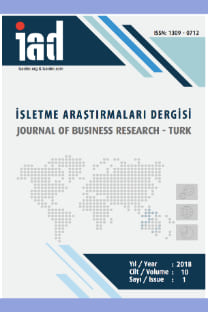Leader-Member Exchange in Different Organizational Cultures and Effects to Organizational Burnout
___
Albrect, K., (1988), Gerilim Altında Yönetici, Çev: K. Tosun vd., İ.Ü. İşletme Fakültesi, Yayın No.197, İstanbul.Bauer, T. N. and Green, S. G. (1996), Development of Leader-Member Exchange: A Longitudinal Test, Academy of Management Journal, 39:6, 1538-1567.
Baumgartner, R.J. (2009). "Organizational culture and leadership: Preconditions for the development of a sustainable corporation", Sustainable Development, 17, 102- 113.
Breland, Jacob W., Treadway, Darren C., Duke, Allison B. ve Adams, Garry L., (2007), "The Interactive Effect of Leader-Member Exchange and Political Skill on Subjective Carrier Success",Journal of Leadership & Organizational Studies, 13 (3), 1-14.
Cameron, K. S., Quinn, R. E. (1992). Diagnosing and changing organizational culture: Based on the competing values framework, Addison-Wesley, Reading, MA.
Deluga, R. J. and Perry, J.T. (1994), The Role of Subordinate Performance and Ingratiation in Leader-Member Exchanges, Group & Organization Studies, 19:1, 67-86.
Dipboye, L. R, Howell, C. W. and Smith, S. C. (1994). Understanding Industrial and Organizational Psychology, An Integrated Approach. ABD Harcourt Brace Koleji Yayınları.
Drucker, F. P. (1992). Managing for the Future. Londra: Butterworth / Heinemann.
Dunegan, K. J., Duchon, D. and Uhl-Bien, M. (1992), Examining the Link between Leader-Member Exchange and Subordinate Performance: The Role of Task Analyzability and Variety as Moderators, Journal of Management, 18:1, 59-76.
Freudenberger, H. J. (1977), Burn-Out: Occupational Hazard of the Child Care Worker, Child Care Quarterly, 6:2, 90-98.
Graen, G.B., Novak, M., & Sommerkamp, P. (1982). The effects of leader-member exchange and job design on productivity and satisfaction: Testing a dual attachment model. Organizational Behavior and Human Performance, 30, 109- 131.
Hetland, H., Sandal, G. and Backer, J. (2007), Burnout in the Information Technology Sector: Does Leadership Matter?, European Journal of Work and Organizational Psychology, 16:1, 58-75.
Hofstede, G. (1980). Culture's Consequences: International Differences in Work-related Values, Sage, Beverly Hills, CA.
Jelena V., Milan, N. Olga, H., Edit, T. and Milena N. (2012). Relationship between GLOBE organizational culture dimensions, job satisfaction and leader-member exchange in Serbian organizations. Journal for East European Management Studies. Vol: 17/3.
Kırkbeşoğlu, E. and Tüzün, İ.K., (2009). "Bireycilik - Toplulukçuluk İkileminde Mesleki Özdeşleşme Ve Örgütsel Özdeşleşme Ayrımı". Organizasyon ve Yönetim Bilimleri Dergisi. Sayı: 1/1, ss. 1 - 8.
Kostera, M. and Wicha, M. (1996). The Divided Self" of Polish State- owned Enterprises: The Culture of Organizing, Organization Studies, 17 (1): 83-105.
Li, J., Lam, K. and Qian, G. (2001). Does Culture Affect Behavior and Performance of Firms? The Case of Joint Ventures in China, Journal of International Business Studies, 32 (1): 115-131.
Liden, R. C. ve Maslyn M. (1998). Multidimensionality of Leader-Member Exchange: An Empirical Assessment through Scale Development, Journal of Management, Vol.24, No.1, 43-72.
Liden, Robert C. ve Graen, George, (1980), "Generalizability of The Vertical Dyad Linkage Model of Leadership", Academy of management Journal, 23 (3), 451- 465.
Maslach, C. (2003). Job burnout: New directions in research and intervention. Current Directions in Psychological Science , 12, 189-192.
Maslach, C. and Jackson, S.E. (1981) The measurement of experienced burnout. Journal of Occupational Behavior 2, 99-113.
Maslach, C., Schaufeli, W. B. and Leiter, M. P. (2001), Job Burnout, Annual Review Psychology, 52 , 397-422.
McCain, A. K. (1994), The Relationship between Head Nurse Leadership Behavior and Staff Nurse Burnout, Phd Thesis, University of Bridgeport, Bridgeport.
Ouchi, W.G. (1987). Teori Z: Japonların Yönetim Tarzı Nasıl İşliyor (Çev. Yakut Güneri), İlgi Yayıncılık, İstanbul.
Pellegrini, E. K. and Scandura, T.A. (2006). Leader-Member Exchange (LMX), Paternalism, and Delegation in The Turkish Business Culture: An Empirical Investigation, Journal of International Business Studies, 37, 264-279.
Schein, E.H. (1997). "Organizational Culture and Leadership" (2. Ed.), Jossey-Bass, San Francisco.
Seltzer, J. and Numerof, R. E. (1988), Supervisory Leadership and Subordinate Burnout, Academy of Management Journal, 312, 439-446.
Steiner, Dirk D. (1997), Attributions in Leader-Member Exchanges: Implications for Practice, European Journal of Work and Organizational Psychology, 6:1, 59-71.
Talat I., Saif ur Rehman Khan, Ungku N. Ungku Bt. Ahmad, Ishfaq ., (2013) "Organizational learning culture and leader-member exchange quality: The way to enhance organizational commitment and reduce turnover intentions", Learning Organization, The, Vol. 20 Iss: 4/5, pp.322 - 337.
Tziner A, Shultz T, Fisher T. (2008). Justice, leader-member exchange, and job performance: are their relationships mediated by organizational culture?. Psychological Reports: Volume 103, Issue , pp. 516-526.
Wayne, S. J., Liden, R. C. and Sparrowe, R. T. (1994), Developing Leader-Member Exchanges the Influence of Gender and Ingratiation, The American Behavioral Scientist, 37:5, 697-714.
- ISSN: 1309-0712
- Yayın Aralığı: 4
- Başlangıç: 2009
- Yayıncı: Melih Topaloğlu
Leader-Member Exchange in Different Organizational Cultures and Effects to Organizational Burnout
ERDEM KIRKBEŞOĞLU, ŞULE TUZLUKAYA
Impact of Worker Remittances on Economic Growth of Pakistan: Analysis of Pakistan's Economy
M Mobeen SHAFQAT, Ashfaq AHMAD, Sadia BANO
M. Fikret ATEŞ, H. Cenk SÖZEN, H. Okan YELOĞLU
İşletmelerin ERP Sistemlerini Kullanım Düzeylerinin Ölçülmesi: Aydin İli Örneği
ÖZEL SEBETCİ, Kâmil BİRCAN, Neslihan DEMİR, Esma ACAYIP
The Effects of Burnout on Organizational Commitment in Logistics Sector
DURSUN YENER, Kader OSKAYBAŞ, TOLGA DURSUN
Impact of Worker Remittances on Economic Growth of Pakistan: Analysis of Pakistan's Economy
